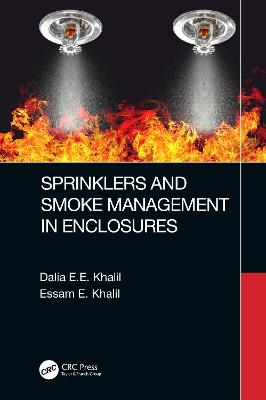
Sprinklers and Smoke Management in Enclosures
CRC Press (Verlag)
978-0-367-86068-4 (ISBN)
This book addresses smoke management in enclosures and provides a platform for understanding the principles of smoke propagation and spread, heat release rate, and the effect of sprinklers on suppression. Considering how sprinkler systems have become a vital part of firefighting systems in enclosures, the book evaluates the effect of sprinkler activation on the behavior of fire-induced smoke and the interaction of water particles with the smoke layer. It studies two base case models where the sprinklers’ effect on the fire curve was considered. This base case was assessed with two smoke extraction systems, namely, a ducted system and an impulse ventilation system. By focusing on key elements, such as visibility, ceiling height, and fire curve, the results of the study will be of interest to mechanical engineers, HVAC professionals, and fire safety professionals and investigators.
Features
Includes case models and scenarios to evaluate real examples from different applications
Studies the effect of sprinkler activation on the behavior of fire-induced smoke
Explores various factors, such as ceiling height, sprinkler operating pressure, and fire curve
Discusses the interaction of water particles with the smoke layer
Utilizes Pyrosim software for CFD modeling
Dalia Essam E. Khalil, PhD, earned a BS (2010) in mechanical engineering, an MS (2012) in energy efficiency for middle-income housing, and a PhD (2019) in sprinklers modeling on car parks at Cairo University, Egypt. Currently, she is a CFD specialist and LEED Accredited Professional at Dar Al-Handasah, part of Dar Group, with ten years of experience in design and simulation of HVAC and firefighting systems, wind simulations, smoke management systems, and healthcare facilities. Essam E. Khalil (PhD, London, DIC) earned a BS (1971) and an MS (1973) in mechanical engineering at Cairo University, Egypt, and a DIC (1976) and a PhD (1977) at the Imperial College of Science and Technology, London University, UK. He has been a professor in the Department of Mechanical Power Engineering, Cairo University, Egypt, since June 1988. He has over 48 years of experience in design and simulation of combustion chambers for terrestrial and aerospace applications. He has published 14 books in English and over 960 papers in journals and conference proceedings on combustion, energy, HVAC, and indoor air quality control. He developed and delivered advanced courses in heat transfer, gas turbine combustion, and terrestrial energy. He is a fellow of ASME, ASHRAE, and AIAA and an ASME George Westinghouse Gold Award recipient in 2009 and ASME Harry Potter Gold Award recipient in 2012. He is a certified consultant engineer, PE. He is a convener of ISO TC205 WG2: Design of Energy Efficient Built Environment and a convener of ISO TC163 WG4 Holistic Approach to Energy Performance of Buildings. He is a member of CEN TC371 WG1 and Egyptian Smart Cities Code Committee and chair of Egyptian and Arab HVAC Code Committee, Egyptian Ventilation Code Committee, and Egyptian Indoor Air Quality Code Committee.
1. Introduction 2. Ventilation and Smoke Management 3. Governing Equations 4. Methodology, Results, and Discussion 5. Proposed Design Options 6. Design of Complex Smoke Management Systems 7. Conclusions and Recommendations for Future Work
| Erscheinungsdatum | 09.06.2020 |
|---|---|
| Zusatzinfo | 12 Tables, black and white; 42 Line drawings, black and white; 134 Halftones, black and white; 176 Illustrations, black and white |
| Verlagsort | London |
| Sprache | englisch |
| Maße | 156 x 234 mm |
| Gewicht | 453 g |
| Themenwelt | Technik ► Bauwesen |
| Technik ► Elektrotechnik / Energietechnik | |
| ISBN-10 | 0-367-86068-6 / 0367860686 |
| ISBN-13 | 978-0-367-86068-4 / 9780367860684 |
| Zustand | Neuware |
| Informationen gemäß Produktsicherheitsverordnung (GPSR) | |
| Haben Sie eine Frage zum Produkt? |
aus dem Bereich


